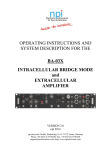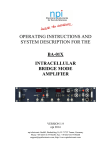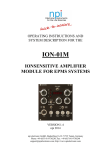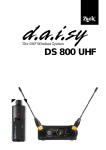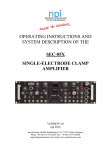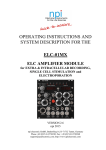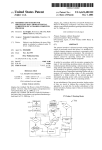Download BA-01M Manual - NPI Electronic Instruments
Transcript
OPERATING INSTRUCTIONS AND SYSTEM DESCRIPTION FOR THE BA-01M INTRACELLULAR BRIDGE MODE AMPLIFIER MODULE FOR EPMS SYSTEMS VERSION 5.1 npi 2014 npi electronic GmbH, Bauhofring 16, D-71732 Tamm, Germany Phone +49 (0)7141-9730230; Fax: +49 (0)7141-9730240 [email protected]; http://www.npielectronic.com BA-01M User Manual _________________________________________________________________________________________________________________ Table of Contents About this Manual ........................................................................................................................ 3 1. Safety Regulations ................................................................................................................. 4 2. EPMS-07 Modular Plug-In System ....................................................................................... 5 2.1. General System Description / Operation .......................................................................... 5 2.2. EPMS-07 Housing ............................................................................................................ 5 2.3. EPMS-E-07 Housing ........................................................................................................ 5 2.4. PWR-03D ......................................................................................................................... 5 2.5. System Grounding ............................................................................................................ 6 EPMS-07 .......................................................................................................................... 6 EPMS-E-07....................................................................................................................... 6 2.6. Technical Data .................................................................................................................. 6 EPMS-07 .......................................................................................................................... 6 EPMS-E-07....................................................................................................................... 6 3. BA-01M Components ........................................................................................................... 7 4. BA-01M System .................................................................................................................... 7 4.1. System Description ........................................................................................................... 7 4.2. Description of the Front Panel .......................................................................................... 8 5. Headstage .............................................................................................................................. 15 5.1. Headstage Elements.......................................................................................................... 15 6. Setting up the BA-01M System............................................................................................. 16 7. Passive Cell Model ................................................................................................................ 17 7.1. Cell Model Description .................................................................................................... 17 7.2. Connections and Operation .............................................................................................. 18 8. Test and Tuning Procedures .................................................................................................. 20 8.1. Headstage Bias Current Adjustment................................................................................. 20 8.2. Offset Compensation ........................................................................................................ 21 8.3. Capacitance Compensation............................................................................................... 21 8.4. Bridge Balance ................................................................................................................. 23 8.5. Electrode Selection ........................................................................................................... 23 9. Sample Experiments .............................................................................................................. 25 9.1. Sample Experiment using a Sharp Electrode ................................................................... 25 9.2. Sample Experiment using a Suction (Patch) Electrode .................................................... 28 10. Trouble Shooting ................................................................................................................... 30 11. Literature ............................................................................................................................... 31 12. Technical Data ....................................................................................................................... 33 Index ............................................................................................................................................. 35 ___________________________________________________________________________ version 5.1 page 2 BA-01M User Manual _________________________________________________________________________________________________________________ About this Manual This manual should help to setup and use the BA-01M system correctly and to perform reliable experiments. If you are not familiar with the use of instruments for intracellular recording of electrical signals please read the manual completely. The experienced user should read at least chapters 1, 4, 5, 6 and 8. Important: Please read chapter 1 carefully! It contains general information about the safety regulations and how to handle highly sensitive electronic instruments. Signs and conventions In this manual all elements of the front panel are written in capital letters as they appear on the front panel. System components that are shipped in the standard configuration are marked with , optional components with . In some chapters the user is guided step by step through a certain procedure. These steps are marked with . Important information and special precautions are highlighted in gray. Abbreviations Cm: Cstray: GND: Imax: Rm: REL: Cm: VREL: cell membrane capacitance electrode stray capacitance ground maximal current cell membrane resistance electrode resistance time constant of the cell membrane potential drop at REL ___________________________________________________________________________ version 5.1 page 3 BA-01M User Manual _________________________________________________________________________________________________________________ 1. Safety Regulations VERY IMPORTANT: Instruments and components supplied by npi electronic are NOT intended for clinical use or medical purposes (e.g. for diagnosis or treatment of humans), or for any other life-supporting system. npi electronic disclaims any warranties for such purpose. Equipment supplied by npi electronic must be operated only by selected, trained and adequately instructed personnel. For details please consult the GENERAL TERMS OF DELIVERY AND CONDITIONS OF BUSINESS of npi electronic, D-71732 Tamm, Germany. 1) GENERAL: This system is designed for use in scientific laboratories and must be operated only by trained staff. General safety regulations for operating electrical devices should be followed. 2) AC MAINS CONNECTION: While working with the npi systems, always adhere to the appropriate safety measures for handling electronic devices. Before using any device please read manuals and instructions carefully. The device is to be operated only at 115/230 Volt 60/50 Hz AC. Please check for appropriate line voltage before connecting any system to mains. Always use a three-wire line cord and a mains power-plug with a protection contact connected to ground (protective earth). Before opening the cabinet, unplug the instrument. Unplug the instrument when replacing the fuse or changing line voltage. Replace fuse only with an appropriate specified type. 3) STATIC ELECTRICITY: Electronic equipment is sensitive to static discharges. Some devices such as sensor inputs are equipped with very sensitive FET amplifiers, which can be damaged by electrostatic charge and must therefore be handled with care. Electrostatic discharge can be avoided by touching a grounded metal surface when changing or adjusting sensors. Always turn power off when adding or removing modules, connecting or disconnecting sensors, headstages or other components from the instrument or 19” cabinet. 4) TEMPERATURE DRIFT / WARM-UP TIME: All analog electronic systems are sensitive to temperature changes. Therefore, all electronic instruments containing analog circuits should be used only in a warmed-up condition (i.e. after internal temperature has reached steady-state values). In most cases a warm-up period of 20-30 minutes is sufficient. 5) HANDLING: Please protect the device from moisture, heat, radiation and corrosive chemicals. ___________________________________________________________________________ version 5.1 page 4 BA-01M User Manual _________________________________________________________________________________________________________________ 2. EPMS-07 Modular Plug-In System 2.1. General System Description / Operation The npi EPMS-07 is a modular system for processing of bioelectrical signals in electrophysiology. The system is housed in a 19” rackmount cabinet (3U) has room for up to 7 plug-in units. The plug-in units are connected to power by a bus at the rear panel. The plug-in units must be kept in position by four screws (M 2,5 x 10). The screws are important not only for mechanical stability but also for proper electrical connection to the system housing. Free area must be protected with covers. 2.2. EPMS-07 Housing The following items are shipped with the EPMS-07 housing: EPMS-07 cabinet with built-in power supply Mains cord Fuse 2 A / 1 A, slow Front covers In order to avoid induction of electromagnetic noise the power supply unit, the power switch and the fuse are located at the rear of the housing. 2.3. EPMS-E-07 Housing The following items are shipped with the EPMS-E-07 housing: EPMS-E-07 cabinet External Power supply PWR-03D Power cord (PWR-03D to EPMS-E-07) Mains chord Fuse 1.6 A / 0.8 A, slow Front covers The EPMS-E-07 housing is designed for low-noise operation, especially for extracellular and multi channel amplifiers with plugged in filters. It operates with an external power supply to minimize distortions of the signals caused by the power supply. 2.4. PWR-03D The external power supply PWR-03D is capable of driving up to 3 EPMS-E housings. Each housing is connected by a 6-pole cable from the one of the three connectors on the front panel of the PWR-03D to the rear panel of the respective EPMS-E housing. (see Figure 1, Figure 3). A POWER LED indicates that the PWR-03D is powered on (see Figure 1). Power switch, voltage selector and fuse are located at the rear panel (see Figure 2). Note: The chassis of the PWR-03D is connected to protective earth, and it provides protective earth to the EPMS-E housing if connected. ___________________________________________________________________________ version 5.1 page 5 BA-01M User Manual _________________________________________________________________________________________________________________ Figure 1: PWR-03D front panel view Figure 2: PWR-03D rear panel view Note: This power supply is intended to be used with npi EPMS-E systems only. 2.5. System Grounding EPMS-07 The 19" cabinet is grounded by the power cable through the ground pin of the mains connector (= protective earth). In order to avoid ground loops the internal ground is isolated from the protective earth. The internal ground is used on the BNC connectors or GROUND plugs of the modules that are inserted into the EPMS-07 housing. The internal ground and mains ground (= protective earth) can be connected by a wire using the ground plugs on the rear panel of the instrument. It is not possible to predict whether measurements will be less or more noisy with the internal ground and mains ground connected. We recommend that you try both arrangements to determine the best configuration. EPMS-E-07 The 19" cabinet is connected to the CHASSIS connector at the rear panel. The CHASSIS is linked to protective earth as soon as the PWR-03D is connected. It can be connected also to the SYSTEM GROUND (SIGNAL GROUND) on the rear panel of the instrument (see Figure 3). Important:: Always adhere to the appropriate safety measures. Figure 3: Rear panel connectors of the EPMS-E-07 2.6. Technical Data 19” rackmount cabinet, for up to 7 plug-in units Dimensions: 3U high (1U=1 3/4” = 44.45 mm), 254 mm deep EPMS-07 Power supply: 115/230 V AC, 60/50 Hz, fuse 2 A / 1 A slow, 45-60 W EPMS-E-07 External power supply (for EPMS-E): 115/230 V AC, 60/50 Hz, fuse 1.6/0.8 A, slow Dimensions of External power supply: (W x D x H) 225 mm x 210 mm x 85 mm ___________________________________________________________________________ version 5.1 page 6 BA-01M User Manual _________________________________________________________________________________________________________________ 3. BA-01M Components The following items are shipped with the BA-01M system: Amplifier module for the EPMS-07 system Headstage GND (2.4 mm) connector for headstage User manual Optional accessories: Electrode holder Suction electrode holder Remote switch for penetration unit Active cell model Passive cell model (see Figure 9) Low noise / low bias current headstage with a reduced current range (:10 headstage, i.e. maximal current is 1.2 nA / 12 nA) Headstage with differential input 4. BA-01M System This manual is related to the standard configuration of the BA-01M system with a standard headstage and standard calibrations of bridge balance, electrode resistance display range etc. as they appear on the front panel. Other configurations are available, e.g. if the BA-01M system is used only for whole cell patch clamp recordings with suction electrodes the BA-01M system can be delivered with adapted calibrations and a low noise / low bias current headstage (see Optional accessories in chapter 3). For details contact npi. 4.1. System Description The npi BA-01M intracellular recording systems are precise current clamp instruments with a bridge circuit to compensate for the resistance of the recording intracellular electrode. For current injection and potential recording a very high impedance voltage-to-current converter with a special input capacitance compensation circuit is used. For methodical reviews see Lalley et al. (1999), Richter et al. (1996), Ogden (1994) and Boulton et al. (1990). The system consists of a module that is plugged in an EPMS-07 housing and a headstage which should be placed close to the recording site. The recording electrode is connected to the headstage via an electrode holder (see also Figure 8). In some setups there is no space for placing the headstage very close to the recording site. In that case the electrode holder can be connected to the headstage via an electrode adapter (see Optional accessories in chapter 3). All electrode connectors use a driven shield approach (for details of this approach see Ogden (1994)) to minimize the effect of the connecting cables. In addition, all headstages are equipped with a ground connector (GND). The standard system is equipped with a headstage capable of injecting a maximal current of approximately ±12 nA into a resistance of 100 M. ___________________________________________________________________________ version 5.1 page 7 BA-01M User Manual _________________________________________________________________________________________________________________ With this headstage the system can be used either with high resistance sharp electrodes for intracellular recordings or with low resistance suction electrodes for whole cell patch clamp recordings. To cover all the needs of electrophysiological research all systems have a large variety of operation and control elements such as BUZZ (cell penetration) mode, EL. CLEAR (electrode clear) facility, ten-turn controls for BRIDGE BALANCE, CAP. COM (capacitance compensation), OFFSET and HOLD. CUR (holding current)., an automated electrode resistance test, a digital DISPLAY for potential, membrane current and electrode resistance, a STEP GATE INPUT and linear CURRENT STIMULUS INPUT. 4.2. Description of the Front Panel Figure 4: BA-01M front panel view (the numbers are related to those in the text below) ___________________________________________________________________________ version 5.1 page 8 BA-01M User Manual _________________________________________________________________________________________________________________ In the following description of the front panel elements each element has a number that is related to that in Figure 4. The number is followed by the name (in uppercase letters) written on the front panel and the type of the element (in lowercase letters). Then, a short description of the element is given. Some elements are grouped in functional units (e.g. BUZZ unit) and are described as units regardless of the order of numbers. (1) HEADSTAGE connector The HEADSTAGE is connected via a flexible cable and a 8-pole connector to the mainframe (see also chapter 5). Caution: Please always adhere to the appropriate safety regulations (see chapter 1). Please turn power off when connecting or disconnecting the headstage from the HEADSTAGE connector! (2) BIAS (bias current) potentiometer With this trim potentiometer the output current of the headstage (headstage BIAS current) can be tuned to zero, range: 200 pA, (see chapter 8.1). (3) + / 0 / - (STEP SIZE) switch + / 0 / - toggle switch to disable the gated stimulus set by STEP SIZE (21) and gated by STEP GATE INPUT TTL (20) or to select the polarity of the gated stimulus (+: gated stimulus positive, 0: gated stimulus disabled, -: gated stimulus negative). (4) OFFSET potentiometer Control to set the output of the electrode preamplifier to zero (ten-turn potentiometer, symmetrical, i.e. 0 mV = 5 on the dial), range: 200 mV (see chapter 8.2). BRIDGE BALANCE unit The BRIDGE BALANCE unit consists of (7) 100 M / 10 M range switch and (5) BRIDGE BALANCE potentiometer. (7) 100 M / 10 M range switch Switch to set the range of the BRIDGE BALANCE potentiometer (100 M position: 0 M to 1000 M, 10 M position: 0 M to 100 M). (5) BRIDGE BALANCE(M) potentiometer If current is passed through the recording electrode the potential deflection caused at the electrode resistance is compensated with this control (ten turn potentiometer, clockwise, calibrated in M, range set by switch (7), see also chapter 8.4). ___________________________________________________________________________ version 5.1 page 9 BA-01M User Manual _________________________________________________________________________________________________________________ (6) CAP.COMP. (capacitance compensation) potentiometer Control for the compensation of the input capacitance (ten turn potentiometer, clockwise, range: 0-30 pF, see chapter 8.3). Caution: This circuit is based on a positive feedback circuit. Overcompensation leads to oscillations that may damage the cell. DISPLAY/CUR.RANGE unit The DISPLAY unit consists of (8) mV, nA, M LEDs, (10) display, (12) VEL / IEL / REL switch and (11) CUR.RANGE switch. (8) mV, nA, M LEDs LEDs which indicate the unit of the reading of the display (10). (10) Display Display for the recorded potential in mV (XXX mV), the electrode current in nA (XX.XX nA) or the electrode resistance in M (XXX M, i.e. 100 correspond to 100 M), selected by toggle switch (12). (12) VEL / IEL / REL switch (display mode selector) Toggle switch to select the mode of the DISPLAY (10). VEL: the potential at the electrode in mV is displayed IEL: the current flowing through the electrode in nA is displayed REL: the resistance of the electrode in M is displayed The selected mode is indicated by the LEDs mV, nA or M (8). The resistance is measured accurately regardless of the correct setting of other front panel elements such as OFFSET, BRIDGE BALANCE etc. Note: With high resistance electrodes (REL>20 M) the displayed value is dependent on the setting of the capacitance compensation. Note: Resistance is measured correctly also in current range x10! Caution: If the mode selector is switched to REL, the BA-01M automatically applies current pulses of 2 nA to the electrode. Therefore, it should not be used during recordings from cells since this current may stimulate or damage the cell. ___________________________________________________________________________ version 5.1 page 10 BA-01M User Manual _________________________________________________________________________________________________________________ (11) x1 / x10 current range switch and LED Switch to set the stimulus current range. x1 (LED off): CURRENT STIMULUS INPUT: CURRENT OUTPUT: HOLD.CUR.: STEP SIZE: 1 nA / V 1 V / nA 9.99 nA max. 9.99 nA max. x10 (LED on): CURRENT STIMULUS INPUT: CURRENT OUTPUT: HOLD.CUR.: STEP SIZE: 10 nA / V 0.1 V / nA 99.9 nA max. 99.9 nA max. HOLD. CUR. (holding current) unit The HOLD. CUR. unit consists of (9) HOLD. CUR. (nA) potentiometer and (14) + / 0 / switch. (9) HOLD. CUR. (nA) (holding current) potentiometer With this control a constant current (holding current) can be generated (ten turn potentiometer, clockwise), calibrated in nA (Imax = 9.99 nA [current range x1] or 99.9 nA [current range x10]). The polarity of this holding current is set by toggle switch (14). (14) + / 0 / - (holding current) switch Switch to disable holding current generation or to set the polarity of the holding current (+: current positive, 0: holding current disabled, -: current negative). BUZZ / EL. CLEAR (buzz / electrode clear) unit The BUZZ / EL. CLEAR unit consists of (13) BUZZ DURATION potentiometer, (15) BUZZ / OFF / REMOTE switch, (16) REMOTE connector and (17) EL. CLEAR switch. ___________________________________________________________________________ version 5.1 page 11 BA-01M User Manual _________________________________________________________________________________________________________________ (13) BUZZ DURATION potentiometer Control to set the duration of the BUZZ (potentiometer, clockwise, linear, range: ~3 ms to ~110 ms). The duration is dependent on the setting of CAP.COMP (5). It is effective in both modes (REMOTE and BUZZ), see also (15). (15) BUZZ / OFF / REMOTE switch Toggle switch to set the mode of BUZZ operation. BUZZ: Switching to BUZZ activates the BUZZ circuit (duration set by (13)). To facilitate the penetration of the cell membrane the BUZZ circuit is provided which is based on oscillations caused by overcompensating the capacitance compensation system. The overcompensation of capacitance compensation yields to very powerful high-frequency oscillations (see Figure 5). OFF: Switching to OFF disables the BUZZ circuit. REMOTE: In the REMOTE position either a hand-held switch or a foot-switch can be used to operate the BUZZ circuit remotely. The remote device is connected via a grounded BNC cable (at connector (16). potential (mV) 12000 8000 4000 0 -4000 -8000 -12000 start stop time (ms) Figure 5: BUZZ function of the BA-01M (16) REMOTE connector BNC connector to attach a remote switch to the BUZZ unit (see also (12)). (17) EL. CLEAR (electrode clear) switch The EL. CLEAR switch is used to activate the electrode clear circuit that can be used to clean the tip of the electrode by passing large amounts of positive or negative currents. The circuit is operated by pushing this switch to +Imax (maximal positive current) or -Imax (maximal negative current). ___________________________________________________________________________ version 5.1 page 12 BA-01M User Manual _________________________________________________________________________________________________________________ (18) CURRENT STIMULUS INPUT 1(10) nA / V connector Analog input BNC connector for applying signals from an external stimulus source. The voltage signal that is connected here is transformed to a proportional current at the electrode with a sensitivity of 1 nA / V or 10 nA / V. The scaling is dependent on the current range setting (please see also #11). For instance an input voltage of 5 V is transformed to an output current of 5 nA in current range x1, and to an output current of 50 nA in current range x10. The signal form remains unchanged. The amplitude of the output current signal (current stimulus) is determined by the amplitude of the CURRENT STIMULUS INPUT. Two examples for operation in current range x1 are given in Figure 6. In A the amplitude of the CURRENT STIMULUS INPUT is 1 V that gives a current stimulus of 1 nA, in B the CURRENT STIMULUS INPUT amplitude is 2 V that is transformed into a current stimulus of 2 nA. CURRENT STIMULUS INPUT current stimulus Figure 6: Input-output relation using CURRENT STIMULUS INPUT Important: The current injected through the electrode is always the sum of the input signal at CURRENT STIMULUS INPUT (18), the holding current set by HOLD. CUR. (9) and switch (14) and the gated stimulus set by STEP SIZE (21) and switch (3). (19) CURRENT OUTPUT 1 (0.1) nA / V connector BNC connector monitoring the stimulating current passed through the electrode (resistance: 250 , range: approximately ±12 nA in current range x1 and approximately ±120 nA in current range x10). ___________________________________________________________________________ version 5.1 page 13 BA-01M User Manual _________________________________________________________________________________________________________________ gated stimulus unit The gated stimulus unit consists of (3) + / 0 / - switch (STEP SIZE switch), (20) STEP GATE INPUT TTL connector and (21) STEP SIZE (nA) digital potentiometer. (3) + / 0 / - (STEP SIZE) switch + / 0 / - toggle switch to disable the gated stimulus set by STEP SIZE (21) and gated by STEP GATE INPUT TTL (20) or to select the polarity of the gated stimulus (+: gated stimulus positive, 0: gated stimulus disabled, -: gated stimulus negative). (20) STEP GATE INPUT TTL connector With this input a current step (gated stimulus) can be generated set by the digital potentiometer STEP SIZE (21) and the polarity switch (3). This current step is gated by a positive digital pulse (3-15 V) applied to the BNC connector The duration of the current step is set by the duration of the gating signal. The amplitude of the current step is set by STEP SIZE (21). Two examples for current range x1 are given in Figure 7. In A STEP SIZE (21) is set to 100, i.e. 1 nA, in B STEP SIZE (21) is set to 200 i.e. 2 nA. STEP GATE INPUT (>3 V) current stimulus Figure 7: Input-output relation using STEP GATE INPUT TTL (21) STEP SIZE (nA) digital potentiometer Control to set the amplitude of the gated stimulus current range x1: (digital potentiometer (X.XX nA) range: 9.99 nA, resolution 10 pA). current range x10: (digital potentiometer (XX.X nA) range: 99.9 nA, resolution 100 pA). (20) POTENTIAL OUTPUT x10mV connector BNC connector monitoring the recorded membrane potential with a gain of ten (resistance: 250 , range: 1000 mV membrane potential) Important: Maximum potential that can be monitored is 1000 mV. This applies also to operation in current range x10!! ___________________________________________________________________________ version 5.1 page 14 BA-01M User Manual _________________________________________________________________________________________________________________ 5. Headstage The BA-01M comes with the standard headstage (range: 12 nA / 120 nA) for connecting glass electrodes with high resistances or suction electrodes for whole cell patch clamp recordings with lower resistances via an electrode holder (see Figure 8). A low noise / low bias current headstage (range: 1.2 nA / 12 nA, see also Optional accessories in chapter 3) for measurement of very small currents is also available. For details contact npi. Figure 8: electrode holder (optional) and headstage of the BA-01M 5.1. 1 2 3 4 Headstage Elements BNC connector for the electrode holder (linked to the driven shield output) REF: not connected GND: Ground connector headstage cable/holding bar The electrode filled with electrolyte is inserted into an electrode holder (optional, see Figure 8) that fits into the BNC connector of the headstage or into an electrode holder adapter (optional, see also Optional accessories in chapter 3). The electrical connection between the electrolyte and the headstage is established using a carefully chlorinated silver wire. Chlorinating of the silver wire is very important since contact of silver to the electrolyte leads to electrochemical potentials causing varying offset potentials at the electrode, deterioration of the voltage measurement etc. (for details see Kettenmann and Grantyn (1992)). For optimal chlorinating of sliver wires an automated chlorinating apparatus (ACL-01) is available (contact npi for details). Ground provides system ground and is linked to the bath via an agar-bridge or a Ag-AgCl pellet. The headstage is attached to the amplifier with the headstage cable (see #4, Figure 8) and a 8-pole connector. The headstage is mounted to a holding bar that fits to most micromanipulators or optionally to a mounting plate or a dovetail adapter. Note: The shield of the BNC connector is linked to the driven shield output and must not be connected to ground. The headstage enclosure is grounded. Caution: Please always adhere to the appropriate safety precautions (see chapter 1). Please turn power off when connecting or disconnecting the headstage from the HEADSTAGE connector! ___________________________________________________________________________ version 5.1 page 15 BA-01M User Manual _________________________________________________________________________________________________________________ 6. Setting up the BA-01M System The following steps should help you set up the BA-01M correctly. Always adhere to the appropriate safety measures (see chapter 1). Usually the BA-01M is shipped mounted in an EPMS-07 housing. If a single BA-01M is delivered the user has to mount the module in the EPMS-07 housing. This is done by performing the basic installation steps. Basic installation Turn off the EPMS-07 system. Remove two front covers from the EPMS-07 housing. Plug in the BA-01M and fasten the amplifier module with four screws. The screws are important not only for mechanical stability but also for proper electrical connection to the EPMS-07 housing. After installation, the BA-01M is attached to the setup by assembling the electrical connections. It is assumed that a cell model will be attached. The connection of the Ag-AgCl pellet or the agar-bridge for grounding the bath is described in chapter 9. Electrical connections Connect the headstage to the HEADSTAGE connector (#1, Figure 4) at the BA-01M. Connect a cell model (see chapter 7) if you want to test the system with a cell model. Connect a digital/analog timing unit or a stimulation device to CURRENT STIMULUS INPUT or to STEP GATE INPUT TTL if you intend to use the gated stimulus unit. Connect a store oscilloscope or a data recording device (i.e. a computer with data acquisition card) to the POTENTIAL OUTPUT and to the CURRENT MONITOR, triggered from the stimulation device. Before using the BA-01M always start with the basic settings to avoid oscillations. Basic settings Turn all controls to low values (less than 1) and the OFFSET in the range of 5 (zero position, see chapter 4.2). Turn POWER switch on. Now the BA-01M is ready for an initial check with the cell model. ___________________________________________________________________________ version 5.1 page 16 BA-01M User Manual _________________________________________________________________________________________________________________ 7. Passive Cell Model The BA-01M can be ordered with a passive cell model as an optional accessory. An active cell model is also available on request (for ref. see Draguhn et al. (1997)). The passive cell model is designed for use with single electrode amplifiers to check the function of the instrument in the following circumstances: 1. just after unpacking to see whether the instrument has been damaged during transport or 2. to train personnel using the instrument or 3. in case of trouble (see also chapter 10) to check which part of the setup does not work correctly e.g. to find out whether the amplifier or headstage is damaged or something is wrong with the electrodes or holders etc. The passive cell model consists only of passive elements, i.e. resistors that simulate the resistance of the cell membrane and the electrodes, and capacitances that simulate the capacitance of the cell membrane. A switch allows simulation of two different cell types: a cell with 50 M and 22 pF (CELL 1, represents an astrocyte like cell) or a “small” cell with 200 M membrane resistance and 100 pF membrane capacitance (CELL 1, represents an neuron like cell). Electrode immersed into the bath or SEAL formation can be mimicked as well. The headstage of the amplifier can be connected to one of two different types of electrodes (see below). 7.1. Cell Model Description Figure 9: passive cell model 1, 3: 2: 4: 5: connectors for the headstage, 1: electrode resistance: 50 M, 3: electrode resistance: 10 M GND ground connector, to be connected to GND jack of the headstage CELL: switch for cell membrane representing a membrane of either 50 M and 22 pF (CELL 1) or 200 M and 100 pF (CELL 2). In GROUND (upper) position the electrodes are connected to ground via a 1 k resistor. In SEAL (lower) position are connected to a 1 G resistor simulating the formation of a GIGASEAL with a patch electrode. ___________________________________________________________________________ version 5.1 page 17 BA-01M User Manual _________________________________________________________________________________________________________________ Figure 10: Schematic diagram of the passive cell model 7.2. Connections and Operation It is assumed that all connections are built as described in chapter 6. Checking the configuration Turn POWER switch of the amplifier off. a) For simulation of an experiment using a suction electrode Connect the BNC jack labeled 10M of the cell model to the BNC connector PEL of the headstage. b) For simulation of an experiment using a sharp electrode Connect the BNC jack labeled 50M of the cell model to the BNC connector PEL at the headstage. For headstages with SMB connector use the supplied SMB to BNC adapter. For a) and b) Connect GND of the cell model to GND of the headstage. Important: When using the differential headstage (optional) the REF connector must not be left open. It must be connected to ground. ___________________________________________________________________________ version 5.1 page 18 BA-01M User Manual _________________________________________________________________________________________________________________ Simulation of electrode in the bath Set switch #4, Figure 9 to the upper position. Set switch #5, Figure 9 to GROUND position. The 1 k resistor simulates the resistance of the bath solution. This can be used to train cancellation of offsets, using the bridge balance and using the capacity compensation. Simulation of SEAL formation Set switch #4, Figure 9 to the upper position. Set switch #5, Figure 9 to SEAL position. The 1 G resistor simulates the SEAL resistance when forming a GIGASEAL in patch clamp experiments. Simulation of intracellular recording Intracellular recordings can be mimicked with one of two cells with different properties. Use the 50 M electrode connector (#1, Figure 9) for an experiment with sharp electrodes or the 10 M electrode connector (#3, Figure 9) for simulating an experiment with patch electrodes. Switch the CELL membrane switch (see #4, Figure 9) to the desired position (CELL 1 or CELL 2). Turn all controls at the amplifier to low values (less than 1) and the OFFSET in the range of 5 (zero position) and the OSCILLATION SHUTOFF in the DISABLED position. Turn POWER switch of the amplifier on. Now you can adjust the amplifier (see below) and apply test pulses to the cell model. The lower position of the CELL membrane switch (CELL 1) simulates a cell with a resistance of 50 M and a capacitance of 22 pF. In the middle position (CELL 2) a cell membrane with 200 M and 100 pF is simulated. ___________________________________________________________________________ version 5.1 page 19 BA-01M User Manual _________________________________________________________________________________________________________________ 8. Test and Tuning Procedures Important: The BA-01M should be used only in warmed-up condition, i.e. 30 minutes after turning power on. The following test and tuning procedures are necessary for optimal recordings. It is recommended to first connect a cell model to the amplifier to perform some basic adjustments and to get familiar with these procedures. It is assumed that all connections are built as described in chapter 6. Important: Except for Headstage bias current adjustment (see 8.1) all adjustments described below should be carried out every time before starting an experiment or after changing the electrode. 8.1. Headstage Bias Current Adjustment Caution: It is important that this tuning procedure is performed ONLY after a warm-up period of at least 30 minutes! The BA-01M system is equipped with a voltage-to-current converter with a very high output impedance which is connected to the recording electrode. The zero current of this unit is tuned with the BIAS current control (see Figure 4 in chapter 4.2). The tuning procedure must be performed regularly (at least once a month) since the bias current changes over time. If very small currents are used (in the 10 pA range) the procedure must be repeated in shorter intervals. The tuning procedure is performed using high-value resistors and/or a cell model. It cannot be performed with an electrode, since there are always unknown potentials involved (tip potential, junction potentials). Disconnected all input signals (except the headstage). Put the holding current switch to position 0 (+ / 0 / - switch, #14, Figure 4). Connect the PEL connector of the headstage to ground. Note: This cannot be done with the cell model. Please use a wire to connect the input of the BNC connector on the headstage to GND of the headstage. Do not use the shield of the BNC connector since it is connected to driven shield. Tune the OFFSET to zero using the OFFSET control (#4, Figure 4, see also chapter 8.2). Remove the wire and attach the cell model or a resistor with a value of about 5 M across the same connection. The value shown at the display (display mode selector (#12, Figure 4) in position VEL) is related to the BIAS current of the headstage according to Ohm's Law. Cancel this voltage by tuning the headstage BIAS current potentiometer (#2, Figure 4). Accuracy: Now in both modes (potential / current) the display should read 000. Due to the limited resolution of the display, unbalanced offsets and thermal drifts, an offset of ±001 to ±002 may occur on the display. This small deviation can be trimmed internally, but this procedure is necessary only if very small currents in the pA range are recorded. ___________________________________________________________________________ version 5.1 page 20 BA-01M User Manual _________________________________________________________________________________________________________________ 8.2. Offset Compensation If an electrode is immersed into the bath solution an offset voltage will appear, even if no current is passed. This offset potential is the sum of various effects at the tip of the electrode filled with electrolyte (“tip potential”, junction potential etc.). This offset voltage must be compensated, i.e. set to zero carefully with the OFFSET control (#4, Figure 4) before recording from a cell. When adjusting the OFFSET make sure that no current flows through the electrode. Thus, it is recommended to disconnect CURRENT STIMULUS INPUT and to disable STEP GATE INPUT TTL and the HOLD. CUR. unit (see chapter 4.2). If a cell model is connected the OFFSET control should read a value around 5, otherwise it is likely that the headstage or the amplifier is damaged. 8.3. Capacitance Compensation High resistances of electrodes and stray capacitances (Cstray) form a low-pass filter which deteriorates the shape of recorded intracellular signals (see also Figure 13). The frequency response of the amplifier is improved considerably by using the capacitance compensation function. This function is based on positive feedback (“negative capacitance”) circuit. The tuning of the capacitance compensation control is performed using pulses applied to the CURRENT STIMULUS INPUT or pulses provided by the electrode resistance test circuit. With the cell model connected or the electrode in the bath the CAP. COMP. control is turned clockwise until there is no artifact on the POTENTIAL OUTPUT (see Figure 11). Make the basic settings at the amplifier (see chapter 6). Connect a cell model or immerse the electrode into the bath as deep as necessary during the experiment. Switch the display mode selector (#12, Figure 4) to VEL. Tune the OFFSET to zero (see chapter 8.2) Switch the display mode selector (#12, Figure 4) to REL or apply pulses to the CURRENT STIMULUS INPUT and watch the POTENTIAL OUTPUT. Compensate the input capacitance as shown in Figure 11 using the CAP. COMP potentiometer (#6, Figure 4). Figure 11 illustrates the capacitance compensation procedure using a 100 M resistor that represents the electrode. The pulses were generated using the automated electrode resistance test circuit of the BA-01M. The upper diagram shows an undercompensated capacitance. In the diagram in the middle the capacitance is slightly overcompensated and in the lower diagram it is well compensated. ___________________________________________________________________________ version 5.1 page 21 BA-01M User Manual _________________________________________________________________________________________________________________ Figure 11: Tuning of the capacitance compensation using a 100 M resistor ___________________________________________________________________________ version 5.1 page 22 BA-01M User Manual _________________________________________________________________________________________________________________ 8.4. Bridge Balance If current is passed through an electrode the occurring voltage deflection (potential drop at REL) affects the recording of membrane potential. Therefore, this deflection must be compensated carefully by means of the BRIDGE BALANCE control. With the cell model connected or the electrode in the bath the BRIDGE BALANCE control is turned on clockwise until there is no artifact on the POTENTIAL OUTPUT (see Figure 12). The procedure can be done in current range x1 or in current range x10. Make the basic settings at the amplifier (see chapter 6). Connect a cell model or immerse the electrode into the bath as deep as necessary during the experiment. Tune the OFFSET to zero (see chapter 8.2) and compensate the input capacitance (see chapter 8.3). This is very important since a badly compensated input capacitance prevents setting the BRIDGE BALANCE to correct values. Apply current pulses to the electrode either using an external stimulator (via the CURRENT STIMULUS INPUT connector (#18, Figure 4) or by using the gated stimulus unit. Watch the POTENTIAL OUTPUT at the oscilloscope and adjust the BRIDGE BALANCE as shown in Figure 12 using the BRIDGE BALANCE potentiometer (#5, Figure 4). After adjustment you should see a straight voltage trace without artifacts caused by the potential drop at REL. Figure 12 illustrates the BRIDGE BALANCE procedure using a 100 M resistor that represents the electrode. The current stimuli were generated using the gated stimulus unit gated by two TTL pulses. The amplitude was set to 0.5 nA. In the upper diagram the bridge is slightly undercompensated and in the diagram in the middle it is slightly overcompensated. The lower diagram shows a well balanced bridge (compensated). Important: BRIDGE BALANCE and CAP. COMP must be tuned several times during an experiment since most parameters change during a recording session. Figure 15 shows artifacts caused by uncompensated stray capacitance and bridge during recording from a cell. It also shows how to cancel these artifacts by tuning with CAP. COMP and BRIDGE BALANCE. OFFSET deviations can be detected by comparing the readout on the potential display before and after an experiment (with the electrode in the tissue, but not in a cell). 8.5. Electrode Selection Electrodes must be tested before use. This is done by applying positive and negative current pulses and by compensating with the BRIDGE BALANCE control. Electrodes which show significant changes in resistance (rectification) cannot be used for intracellular recordings. By increasing the current amplitude the capability of the electrode to carry current can be estimated. The test current must cover the full range of currents used in the experiment. Sometimes the performance of electrodes can be improved by breaking the tip or by using the BUZZ or ELECTRODE CLEAR facilities of the amplifier. ___________________________________________________________________________ version 5.1 page 23 BA-01M User Manual _________________________________________________________________________________________________________________ Figure 12: Tuning of the BRIDGE BALANCE using 100 M resistor ___________________________________________________________________________ version 5.1 page 24 BA-01M User Manual _________________________________________________________________________________________________________________ 9. Sample Experiments In the following the basics of a simple experiment are described either using a sharp or a suction electrode. It is assumed that all connections are built as described in chapter 6. Before starting remove the cell model. 9.1. Sample Experiment using a Sharp Electrode Figure 13: Model circuit for intracellular recording using a sharp electrode Cm: membrane capacitance, Cstray: electrode stray capacitance, REL: electrode resistance, Rm: membrane resistance Connect the electrode cable / holder to the BNC connector and the Ag-AgCl pellet or the agar-bridge for grounding the bath with GND at the headstage. Make the basic settings (see chapter 6). Again: It is of major importance that the BA-01M systems are used only in warmed-up condition i.e. 30 minutes after turning power on. Adjust BIAS CURRENT to zero if necessary (see chapter 8.1) Reconnect the STIMULUS INPUT and/or the STEP GATE INPUT and put an electrode into the electrode holder. Immerse the electrode into the bath (not in a cell) as deep as necessary during the experiment. Test the capability of the electrode to carry current (see chapter 8.5), compensate the potential offset (see chapter 8.2), measure the electrode resistance (see #9, chapter 4.2) and compensate the input capacitance (see chapter 8.3 and Figure 11). Apply current steps to the CURRENT STIMULUS INPUT and adjust the BRIDGE BALANCE to suppress all artifacts on the POTENTIAL OUTPUT(see chapter 8.4). ___________________________________________________________________________ version 5.1 page 25 BA-01M User Manual _________________________________________________________________________________________________________________ Now the system is preadjusted for measurements. Find a cell! Approach the desired cell. There are several indications that the electrode is very close to the cell membrane: - the electrode resistance increases (the bridge balance appears undercompensated) extracellular action potentials (APs) are recorded the acoustic monitor signal changes Set the DURATION potentiometer to one fourth and apply a BUZZ to the electrode. If you are lucky the tip of the electrode is now inside the cell. If necessary readjust BRIDGE BALANCE and/or CAP. COMP as shown in Figure 14 and Figure 15 using current stimuli that do not activate ion channels or transporters. You read the membrane potential and can apply current pulses to the cell. After penetration the voltage responses of the cell to the test pulses should reflect the cell membrane resistance and time constant. Start the experiment. Figure 14: Adjustment of the bridge balance after penetrating a cell ___________________________________________________________________________ version 5.1 page 26 BA-01M User Manual _________________________________________________________________________________________________________________ Figure 15: Artifacts caused by the recording electrode. The measurements were done using a cell model with 100 M membrane resistance, 100 pF membrane capacitance and 100 M electrode resistance. A: Cstray and VREL not compensated (bridge not balanced) B: Cstray: compensated and VREL not compensated C: Cstray and VREL compensated (bridge balanced) Cm: membrane capacitance, Cstray: electrode stray capacitance, REL: electrode resistance, Rm: membrane resistance, Cm: time constant of the cell membrane, VREL: potential drop at REL (see also Figure 13) ___________________________________________________________________________ version 5.1 page 27 BA-01M User Manual _________________________________________________________________________________________________________________ 9.2. Sample Experiment using a Suction (Patch) Electrode If suction electrodes are used for whole cell recordings they are usually called “pipettes”. Thus, in this subchapter “pipette” means “suction electrode” . Figure 16: Model circuit for whole cell patch clamp recording using a suction electrode Cm: membrane capacitance, Cstray: electrode stray capacitance, REL: electrode resistance, Rm: membrane resistance Prepare the setup and proceed as described in the previous subchapter (9.1) until you have selected a cell. Before immersing the pipette into the bath apply slight positive pressure to the pipette to prevent settling of particles at the tip. Apply test pulses to the pipette (about 10 pA). The resulting voltage signals at the pipette are very small (50 µV with a 5 M electrode). Approach the cell until the voltage signal changes (a, Figure 17). Often you can observe a slight dent in the cell membrane. Release pressure from the pipette. Now forming of the seal is indicated by the voltage deflections getting much larger. If the seal does not form apply gentle suction to the pipette until a gigaseal is established (b, Figure 17). Apply stronger suction to the pipette or use the BUZZ unit to brake the cell membrane under the pipette and establish the whole cell configuration. The whole cell configuration is established if you see the voltage signal getting smaller again (c, Figure 17) and you read the expected membrane potential. Read the membrane potential and if necessary, readjust the BRIDGE BALANCE as shown in 8.4 and Figure 14 and Figure 15. Start the experiment. ___________________________________________________________________________ version 5.1 page 28 BA-01M User Manual _________________________________________________________________________________________________________________ Figure 17: Approaching the cell, forming a gigaseal and establishing the whole cell configuration ___________________________________________________________________________ version 5.1 page 29 BA-01M User Manual _________________________________________________________________________________________________________________ 10. Trouble Shooting In the following section some common problems, possible reasons and their solutions are described. Important: Please note that the suggestions for solving the problems are only hints and may not work. In a complex setup it is impossible to analyze problems without knowing details. In case of trouble always contact an experienced electrophysiologist in your laboratory if possible and connect a cell model to see whether the problem occurring with electrodes and “real” cells persists. Problem 1: After immersing the electrode into the bath there is an unusual high potential offset. Possible reasons: 1. The Ag-AgCl coating of the silver wire in the electrode holder is damaged 2. The Ag-AgCl pellet or Ag-AgCl coating of the silver wire in the agar-bridge are damaged 3. There is an unwanted GND-bridge e.g. caused by a leaky bath 4. The headstage or the amplifier has an error Solutions: 1. Chloride the silver wire again 2. Exchange the pellet or chloride the silver wire in the agar-bridge 3. Try to find the GND-bridge and disconnect it e.g. by sealing the bath 4. Contact npi Problem 2: Even if no stimulus is given a current flows through the electrode Possible reason: 1. The BIAS current is not adjusted Solution: 1. Adjust the BIAS current according the procedure described in chapter 8.1 Problem 3: The system oscillates Possible reason: 1. The capacitance of the electrode is overcompensated Solution: 1. Turn the CAP. COMP potentiometer (#5, Figure 4) to the most left position and compensate the input capacitance again Problem 4: With the cell model connected the REL display does not show the correct value (within a tolerance of 2%). Possible reason: 1. The capacitance of the electrode is not compensated (using the 100 M electrode) 2. The headstage has an error Solution: 1. Turn the CAPACITY COMPENSATION potentiometer (#5, Figure 4) to the most left position and compensate the input capacitance again 2. Contact npi ___________________________________________________________________________ version 5.1 page 30 BA-01M User Manual _________________________________________________________________________________________________________________ 11. Literature Ogden DC (1994) Microelectrode Techniques. The Plymouth Workshop Handbook, Second Edition, The Company of Biologists Limited, Cambridge Polder, H.R., M. Weskamp, K. Linz & R. Meyer (2004) Voltage-Clamp and Patch-Clamp Techniques, Chapter 3.4, 272-323 in: Dhein, Stefan; Mohr, Friedrich Wilhelm; Delmar, Mario (Eds.) Practical Methods in Cardiovascular Research, Springer, Berlin, Heidelberg and New York 2004. Windhorst, U. and H. Johansson (eds.) Modern Techniques in Neuroscience Research, Springer, Berlin, Heidelberg, New York Behrend, O., Branoner, F., Zhivkov, Z., & Ziehm, U. (2006). Neural responses to water surface waves in the midbrain of the aquatic predator Xenopus laevis laevis. Eur.J Neurosci. 23, 729-744. Blomeley, C. P., Kehoe, L. A., & Bracci, E. (2009). Substance P Mediates Excitatory Interactions between Striatal Projection Neurons. Journal of Neuroscience 29, 4953-4963. Burrell, B. D. & Sahley, C. L. (2004). Multiple forms of long-term potentiation and longterm depression converge on a single interneuron in the leech CNS. J Neurosci. 24, 40114019. Burrell, B. D. & Sahley, C. L. (2005). Serotonin Mediates Learning-Induced Potentiation Of Excitability. Journal of Neurophysiology 94, 4002-4010. Drion, G., Bonjean, M., Waroux, O., Scuvee-Moreau, J., Liegeois, J. F., Sejnowski, T. J., Sepulchre, R., & Seutin, V. (2010). M-type channels selectively control bursting in rat dopaminergic neurons. Eur.J Neurosci. 31, 827-835. Gollisch, T., Schutze, H., Benda, J., & Herz, A. V. (2002). Energy integration describes sound-intensity coding in an insect auditory system. J Neurosci. 22, 10434-10448. Grey, K. B. & Burrell, B. D. (2010). Co-induction of LTP and LTD and its regulation by protein kinases and phosphatases. J Neurophysiol. 103, 2737-2746. Hutzler, M., Lambacher, A., Eversmann, B., Jenkner, M., Thewes, R., & Fromherz, P. (2006). High-resolution multi-transistor array recording of electrical field potentials in cultured brain slices. J Neurophysiol. Kettenmann, H. & Grantyn, R. (eds.) (1992) Practical Electrophysiological Methods, Wiley-Liss, New York Lalley, P.M., A.K. Moschovakis and U. Windhorst (1999) Electrical Activity of Individual Neurons in Situ: Extra- and Intracellular Recording, in: U. Windhorst and H. Johansson (eds.) Modern Techniques in Neuroscience Research, Springer, Berlin, New York Maier, N., Nimmrich, V., & Draguhn, A. (2003). Cellular and network mechanisms underlying spontaneous sharp wave-ripple complexes in mouse hippocampal slices. J Physiol 550, 873-887. Mayer-Waarden, K. (1975) Einführung in die biologische und medizinische Meßtechnik. Schattauer-Verlag, Stuttgart. ___________________________________________________________________________ version 5.1 page 31 BA-01M User Manual _________________________________________________________________________________________________________________ Möck, M., Butovas, S., & Schwarz, C. (2006). Functional unity of the ponto-cerebellum: evidence that intrapontine communication is mediated by a reciprocal loop with the cerebellar nuclei. J Neurophysiol. 95, 3414-3425. Neher, E. (1974) Elektrische Meßtechnik in der Physiologie. Springer-Verlag, Berlin. Nimmrich, V., Maier, N., Schmitz, D., & Draguhn, A. (2005). Induced sharp wave-ripple complexes in the absence of synaptic inhibition in mouse hippocampal slices. Journal of Physiology 563, 663-670. Ogden DC (1994) Microelectrode Techniques. The Plymouth Workshop Handbook, Second Edition, The Company of Biologists Limited, Cambridge Prinz, A. A. and P. Fromherz (2000). Electrical synapses by guided growth of cultured neurons from the snail Lymnaea stagnalis, Biol. Cybern. 82, L1-L5 Prinz, A. A. & Fromherz, P. (2003). Effect of neuritic cables on conductance estimates for remote electrical synapses. J Neurophysiol. 89, 2215-2224. Purves, R.D. (1981) Microelectrode Methods for Intracellular Recording and Ionophoresis. London: Academic Press Rotte, C., Krach, C., Balfanz, S., Baumann, A., Walz, B., & Blenau, W. (2009). Molecular characterization and localization of the first tyramine receptor of the American cockroach (Periplaneta americana). Neuroscience. 162, 1120-1133. Schaette, R., Gollisch, T., & Herz, A. V. M. (2005). Spike-Train Variability of Auditory Neurons in vivo:Dynamic Responses Follow Predictions from Constant Stimuli. Journal of Neurophysiology 93, 3270-3281. Schnell, B., Joesch, M., Forstner, F., Raghu, S. V., Otsuna, H., Ito, K., Borst, A., & Reiff, D. F. (2010). Processing of horizontal optic flow in three visual interneurons of the Drosophila brain. J Neurophysiol. 103, 1646-1657. Schoen, I. & Fromherz, P. (2007). The Mechanism of Extracellular Stimulation of Nerve Cells on an Electrolyte-Oxide-Semiconductor Capacitor. Biophys.J., 92, 1096-1111. Vogel, A., Hennig, R. M., & Ronacher, B. (2005). Increase of neuronal response variability at higher processing levels as revealed by simultaneous recordings. Journal of Neurophysiology, 93, 3548-3559. Volgushev, M., Malyshev, A., Balaban, P., Chistiakova, M., Volgushev, S., & Wolf, F. (2008). Onset dynamics of action potentials in rat neocortical neurons and identified snail neurons: quantification of the difference. PLoS.ONE. 3, e1962. Zeck G. and P. Fromherz (2001). Noninvasive neuroelectronic interfacing with synaptically connected snail neurons immobilized on a semiconductor chip, PNAS, 98, (18), 10457–10462 ___________________________________________________________________________ version 5.1 page 32 BA-01M User Manual _________________________________________________________________________________________________________________ 12. Technical Data BA-01M Headstage: Input voltage range: Operating voltage: Enclosure: Holding bar: Electrode connector: Ground connector: REF connector (optional): Input resistance: Current range x1: Current range x10: ±1000 mV ±15 V Size: 23 x 70 x 26 mm, grounded Size: length 150 mm, 8 mm BNC with driven shield 2.4 mm connector SMB connector >1013 (internally adjustable) ±12 nA into 1 G ±120 nA into 100 M Electrode parameter controls: BIAS: range ±200 pA, current adjustable with trim potentiometer OFFSET: range ±200 mV, ten-turn control capacitance compensation: range 0 – 30 pF, ten-turn control Cell penetration: overcompensation of capacitance compensation (BUZZ), duration ~3 – ~110 ms (dependent on the setting of capacitance compensation), timer controlled with linear control, accessible with remote switch Electrode clear circuit: Application of max. DC currents (-Imax or +Imax) Bridge balance: Adjustable with ten-turn control, 0-1000 M Electrode resistance test: 10 mV / M obtained by application of square current pulses ±2 nA, display XXXX M Bandwidth and speed response: Full power bandwidth (REL = 10 k): (Square pulse, 1V pp) >10 kHz, rise time (10% - 90%) 40 µs (voltage), 30 µs (current) (REL = 100 M) 25 µs (voltage and current) (REL = 5 M) ___________________________________________________________________________ version 5.1 page 33 BA-01M User Manual _________________________________________________________________________________________________________________ Outputs: 50 BNC connector, sensitivity 1 nA / V, display XX.XX nA, resolution 10 pA BNC connector, sensitivity 0.1 nA / V, display XXX.X nA, resolution 100 pA BNC connector, sensitivity x10 mV, display XXXX mV Resistance: Current x1: Current x10: Potential: Inputs: Current x1 Current stimulus input via BNC connector, sensitivity 1 nA / V Step gate input via BNC connector, gated stimulus with digital control of current step size (X.XX nA). Max. step size: 9.99 nA, resolution: 10 pA; polarity selectable with toggle switch, holding current range: ±10 nA, adjustable with ten-turn control Current x10 Current stimulus input via BNC connector, sensitivity 10 nA / V Step gate input via BNC connector, gated stimulus with digital control of current step size, (XX.X nA). Max. step size: 99.9 nA, resolution: 100 pA; polarity selectable with toggle switch, holding current range: ±100 nA, adjustable with ten-turn control Dimensions: Front panel: Housing: 24 HP (121.5 mm) x 3U (128.5 mm) 7” (175 mm) deep EPMS-07 system Power requirements: 115/230 V AC, 60/50 Hz, fuse 2 A / 1 A, slow, 45-60 W (depending on the modules plugged in) Dimensions: 19” rackmount cabinet, 3U high (1U = 1 3/4” = 44.45 mm) ___________________________________________________________________________ version 5.1 page 34 BA-01M User Manual _________________________________________________________________________________________________________________ Index abbreviations 3 accessories 7 basic installation 16 basic settings 16 bias current adjustment 20 BIAS current potentiometer 9 bridge balance 23, 24, 26 BRIDGE BALANCE unit 9 BUZZ / EL. CLEAR (buzz / electrode clear) unit 11 CAP.COMP. potentiometer 10 cell model 17 connections and operation 18 description 17 components 7 CURRENT MONITOR connector 13 CURRENT STIMULUS INPUT connector 13 DISPLAY/CUR.RANGE unit 10 electrical connections 16 electrode 21 artifacts 27 capacity compensation 21 offset compensation 21 selection 23 front panel view 8 gated stimulus unit 14 general description 7 headstage 15 elements 15 HEADSTAGE connector 9 HOLD. CUR. (holding current) unit 11 literature 31 model circuit sharp electrode 25 OFFSET potentiometer 9 POTENTIAL OUTPUT connector 14 safety regulations 4 sample experiments 25 sharp electrode 25 suction (patch) electrode 28 sealing 29 sharp electrode 25 suction electrodes 28 technical data 33 testing 20 trouble shooting 30 tuning 20 ___________________________________________________________________________ version 5.1 page 35



































